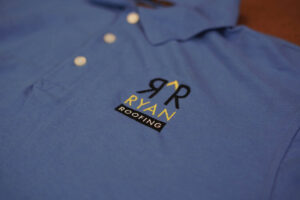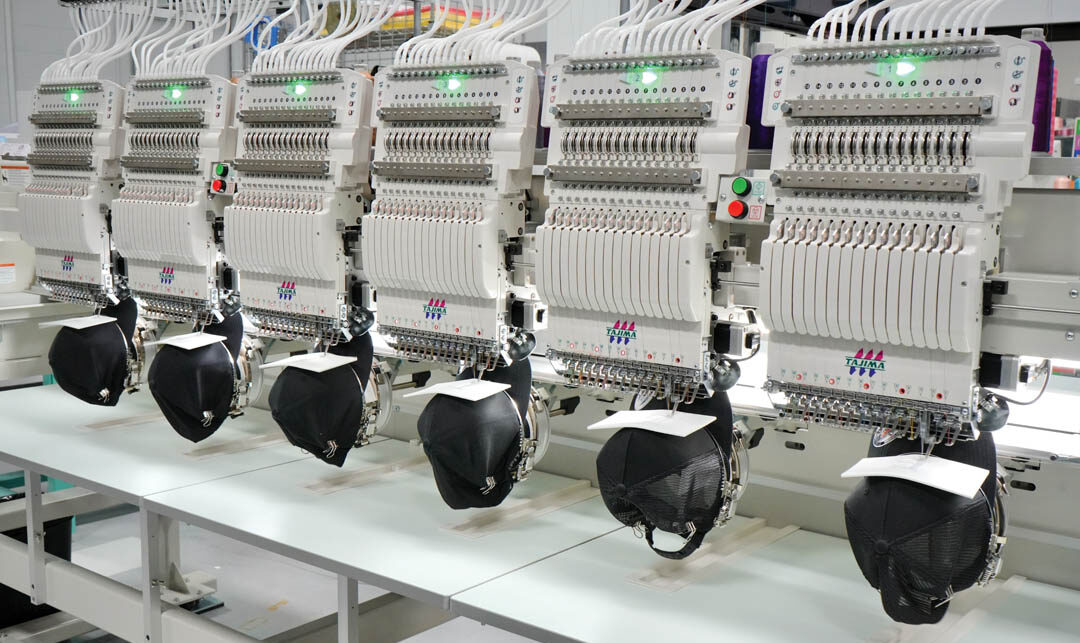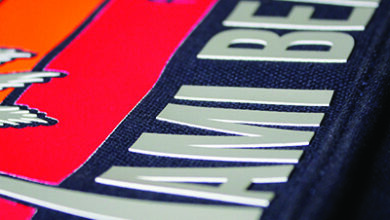Starting an embroidery business can be a low-cost way to enter the textile and apparel industry, but according to those already in the business, there are a few key things to know before investing in equipment.
“My first tip is to do your research, and even look at other countries,” said Rene Rosales, marketing and education manager for TEXMAC Inc., a machining manufacturer in Charlotte, North Carolina. “You’re going to see a wide range of prices, but the cheapest isn’t always best.”
TEXMAC represents a single brand of industrial embroidery machines, HappyJapan, and is the sole distributor in the U.S. and Canada of the company’s single-head and multi-head embroidery machines, providing related support, training, and maintenance services.

“As objectively speaking as I can be, it seems like the German and Japanese brands take development, reliability, and consistency more seriously,” Rosales said. “In our experience in the market, we’ve seen competitors in the U.S., Germany, Japan, and China, and the more reliable brands tend to be made in Germany and Japan.”
Rosales recommends seeking referrals and checking online forums free of manufacturer bias, even places like Facebook or Reddit, for customer complaints and recommendations.
“Educate yourself as much as you can, and check out multiple sources, especially competing distributors and brands, and get their stories,” Rosales said. “Talk to actual customers, embroiderers, as opportunities arise.”
Those conversations are important, since there are many factors to consider, said Josh Welch, applications team manager for Melco in Westminster, Colorado.
“Before buying an embroidery machine, consider factors like reliability, sew field size, ease of use, and ongoing maintenance needs,” Welch said. “Ensure the machine can handle your expected production volume without compromising quality or efficiency.”
Ed Levy, vice president of technology for Hirsh Solutions in Huntersville, North Carolina, suggests choosing that quality over price.
“There are a lot of machines entering the marketplace that focus solely on price and lack in quality components, training, and after-sales support. Investing in an embroidery machine is an investment in your future,” Levy said. “One of the most important things to know is whether or not the embroidery machine is capable of performing the work that you need to perform. For example, if headwear will be an important portion of your business, ensure that the machine is capable of embroidering on caps.”

Another tip is to compare the monthly payments for purchasing an embroidery machine to the amount of income that can be generated from the machine’s use, for anything from polo shirts, jackets, caps, blankets, and T-shirts to patches and applique, Rosales said. An entry-level machine will cost less, but opting for that
higher quality often does not make a big difference in the monthly payment, he said.
“Look at the fee structure for larger designs — your embroidery fee — and how that breaks down profitability,” Rosales said, adding that the main cost is the embroidery blanks bought wholesale, not the cost of the machine. “The more sales you do in a month, the smaller the difference in monthly payments for your machine versus a higher-end machine — that difference is small.”
A larger equipment investment also means a more reliable, durable machine with a longer warranty and additional support. The machine typically will have more powerful motors, giving it the ability to sew on a wider range of materials and thicker and tougher substrates, such as one-fourth-inch leather and bulky hoodies, without any problems or degradation
of quality.
Machine size

Another decision to consider is the size of the machine, such as single- or multi-head (two, four, six, eight, or 12), based on the anticipated order volume, Rosales said. He recommends starting out with a single-head machine to run samples or small orders.
A multi-head machine, alternatively, can handle large orders but of the same design for each order — a six-head machine would be able to handle six garments at a time, for example. One brand does different designs on the same machine, as Rosales pointed out, but it’s no more convenient than having two separate machines, since it requires accommodating different drive systems and additional power and operational space.
“A retail shop or personalization-based items might warrant a single-head, while high-volume contract orders might require a six-, eight-, or 12-head machine,” Levy said. “A single-head will always be one of a shop’s most valuable machines as they are extremely versatile for small orders, repair work, or personalization. Regardless of growth, many embroidery companies rely on one or more single-head embroidery machines in their daily workflow.”
A single-head machine typically can operate on household power of 110 to 120 volts, while a multi-head machine requires 220 volts in a commercial setup, but it’s best to first consult with an electrician, Rosales said.
“If you’re serious about a full-time embroidery business, starting with a full-size industrial machine is key,” Welch said. “Smaller machines may be more affordable upfront, but they often can’t keep up with growing demand. For established shops, a multi-head or module system is a great option that can scale with your business, supporting future growth. Entry-level, single-head machines are fine for learning and sampling, but they rarely generate enough production or profit long-term. Starting with the right equipment sets you up for scalability and success from day one.”
As far as space, a single-garment machine can be operated in a home, since the footprint is small (about four square feet per head), plus there needs to be room for a table to fit the substrate into the hoops and to box up the final products, Rosales said, adding that the machinery also is quiet.
“One thing unique about the embroidery business is it scales up — one operator can run several machines at a time without penalty labor-wise. It scales up pretty well as long as you have the budget and space for it,” Rosales said. “There are no dryers or chemical drains that other decorated apparel methods would require.”
Supplies

Embroidery doesn’t require a lot of supplies either, though a good quality thread is important, Rosales said. Other supplies include bobbins, backing, topping, scissors, nippers, oil, and a seam ripper or stitch remover.
“The commercial threads are able to withstand a higher tension and maintain a consistent tension,” Rosales said. “Most established brands out there all work.”
Also important is the stabilizer, which is the piece of material placed behind the shirt or other substrate to counteract shifting and distorting as the machine moves over the substrate. The result is stitching that’s reliable and consistent and that has clarity.
“Most embroidery machines include a basic starter kit with hoops and essential accessories, but you’ll need additional supplies to get started,” Welch said. “Try to find a reputable supplier that stocks all these items to cut down on shipping costs. Choose quality materials from a reputable supplier to ensure professional results.”
Hoops are an attachment that holds the garment securely in place, stretching it taut to prevent puckering during the stitching of the design. Specialty clamps and frames are also used for materials that are bulky or unusually shaped to hold them in place, such as bags, gloves, shoes, and belts.
“Hooping garments flat on a table can be slow and inconsistent, while a hooping station ensures faster, more accurate results, especially as production increases,” Welch said.
Maintenance
In addition to getting the right supplies, embroidery machines need routine maintenance, primarily oiling and cleaning, typically on a six-month or annual cycle.
“Most manufacturers provide a preventative maintenance schedule,” Levy said. “Ongoing preventative maintenance will help prevent costly repairs.”
That includes regularly oiling the hook, as well as the other oiling points as recommended by the manufacturer, and keeping the machine clean from dirt, dust, and any type of spray adhesive, Levy said.
“Having a technician visit and perform an annual tune-up is always a great idea,” Levy said. “This will help protect your investment and increase your profitability by having a machine that performs at optimal levels.”
Any worn consumable parts should be replaced, and critical measurements should be checked to keep the machine running at peak performance, Welch said.
“Proper adjustments not only extend the machine’s lifespan but also ensure consistently high-quality embroidery,” Welch said. “Additionally, try to keep the machines themselves as clean as possible. Dirt and debris can stain garments and compromise your work.”
Rosales recommends maintaining contact with the support department for any questions and being aware of parts that may no longer be available.
“Check to make sure things are good and tight, and if any parts need to be replaced,” Rosales said. “Things may get knocked out of adjustment, but it’s not hard to do yourself. A good, properly cared for machine can last 20 years.”
Digitizing
Embroiderers can hire out or learn how to digitize the image or logo that’s to be embroidered on the substrate. A digitizer has the skills and knowledge to translate the image into designs and draw the lines and shapes so that they are compatible with stitching. Different types of substrates may require different setups based on thickness and other features, such as a hat or hoodie — they also may need alternative needle types, hooping devices, or stabilizers to perform the stitching.
Rosales recommends outsourcing the digitizing step, at least initially, since there isn’t an ROI of doing it in-house, given the amount of time it takes and the fact that the job can be hired for less overseas, he said. Plus, trained digitizers understand how to achieve consistent quality on different types of materials, such as a shirt versus a hoodie, and can provide a quicker turnaround time.
“Digitizing is an acquired skill. You don’t take a training class and then all of a sudden produce world-class designs,” Levy said. “However, you need to provide your customer with a high-quality design from day one.”
Levy recommends that embroidery software purchases include digitizing capabilities in case it’s brought in-house. They can include features like scaling, recoloring, merging designs, and adding text.
“You can still outsource most designs, but do simple designs, or as your skill progresses, do a small portion of the digitizing, especially if it means that you can provide better service to your customers,” Levy said. “Having digitizing capabilities helps provide a faster ROI than only having a lettering or editing system.”
Continuing education
Finally, Rosales recommends that embroiderers be open to education and learning about new technology. This includes learning about aspects of the embroidery machines, as well as how embroidery is created, even using digital education as a primary source. High-quality and more established brands include a training program with the purchase of the machine, he said.
“At the beginning, take in as much education as possible,” Rosales said, recommending beginner, then maintenance classes. “Be aware of what you need to know, even if you can’t learn it all at once.”
He concluded, “User interfaces are getting better. Prices have fallen, and the quality and user-friendliness of the machines and software have gone up.”




